Discover this quick and easy recipe that transforms simple ingredients into an exquisite and nutritious salad! With this quinoa and mango salad, you will find taste happiness in freshness, while providing your family with a healthy and plant-based meal.
No hours spent in the kitchen, just fun on the plate in a few steps. Who said eating well had to be complicated?
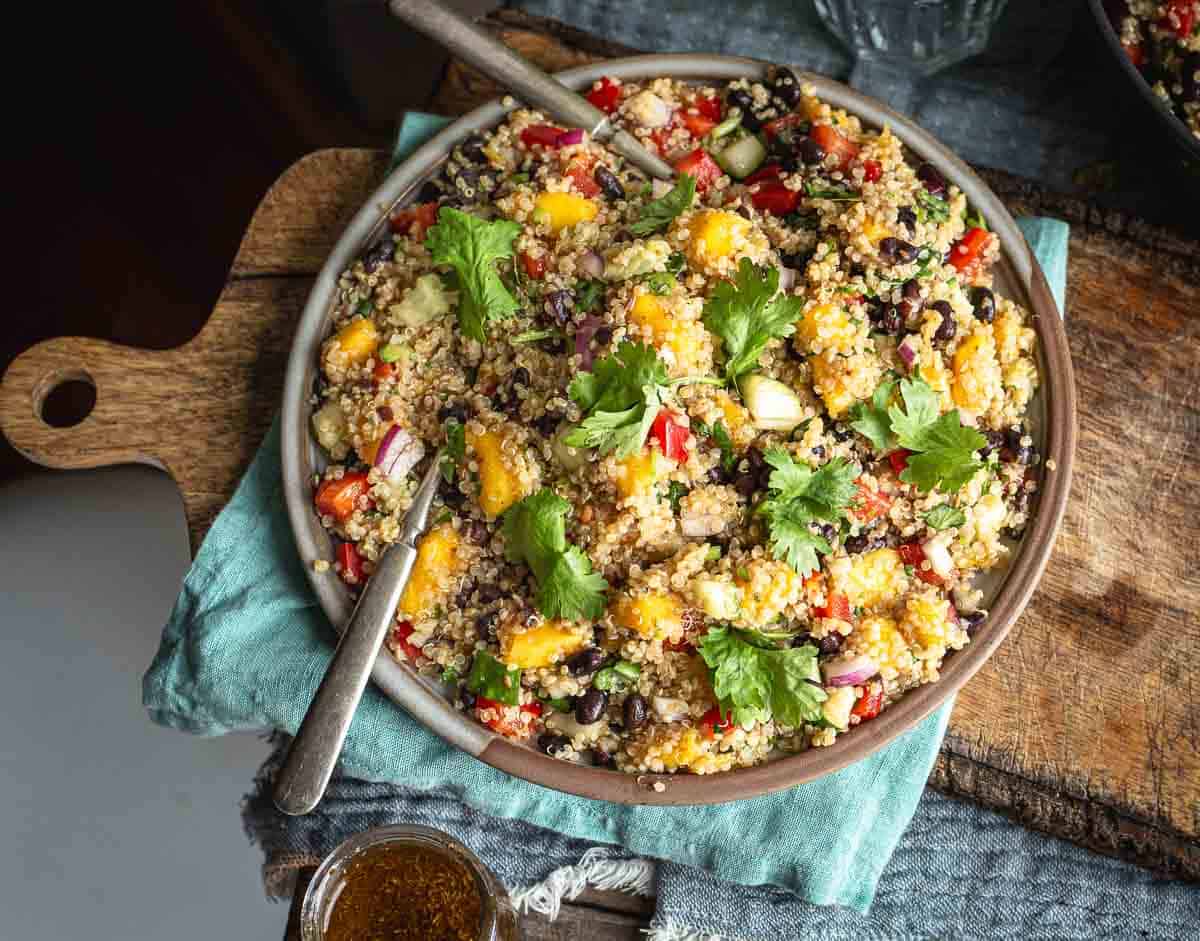
Watch how it’s Done
Watch the recap with the Mango Quinoa Salad Web Story. It's done in the blink of an eye!
Jump to:
Why this Recipe Rocks
This quinoa salad with black beans and mango is a favorite that I discovered thanks to Ali Vincent, former contestant of the show The Biggest Loser. She shared it enthusiastically and since then, it has been a hit, reaching homes all over America!
We all have those days when time seems to fly like a shooting star, where the "subway, work, sleep" leaves us barely a minute to think about what we will be able to prepare for dinner. Yes, I get you!
This great salad has everything to please and meets all your expectations: healthy, simple, fast, plant-based and full of flavors. Everyone at home loves it!
This dish is quite a delight: the nutty quinoa, which crunches gently under the tooth, the melting black beans and the juicy mango that adds an exotic and sweet note. It's like an explosion of flavors in your mouth, a real taste fireworks. And the maple syrup dressing is fire!
And the best part? It pairs beautifully with other plant-based dishes and is perfect for a light lunch, a quick dinner on weekdays or a summer picnic on the weekend. So, ready to get started? I'm going to pour myself another helping of this irresistible salad. I look forward to your verdict!
Ingredients
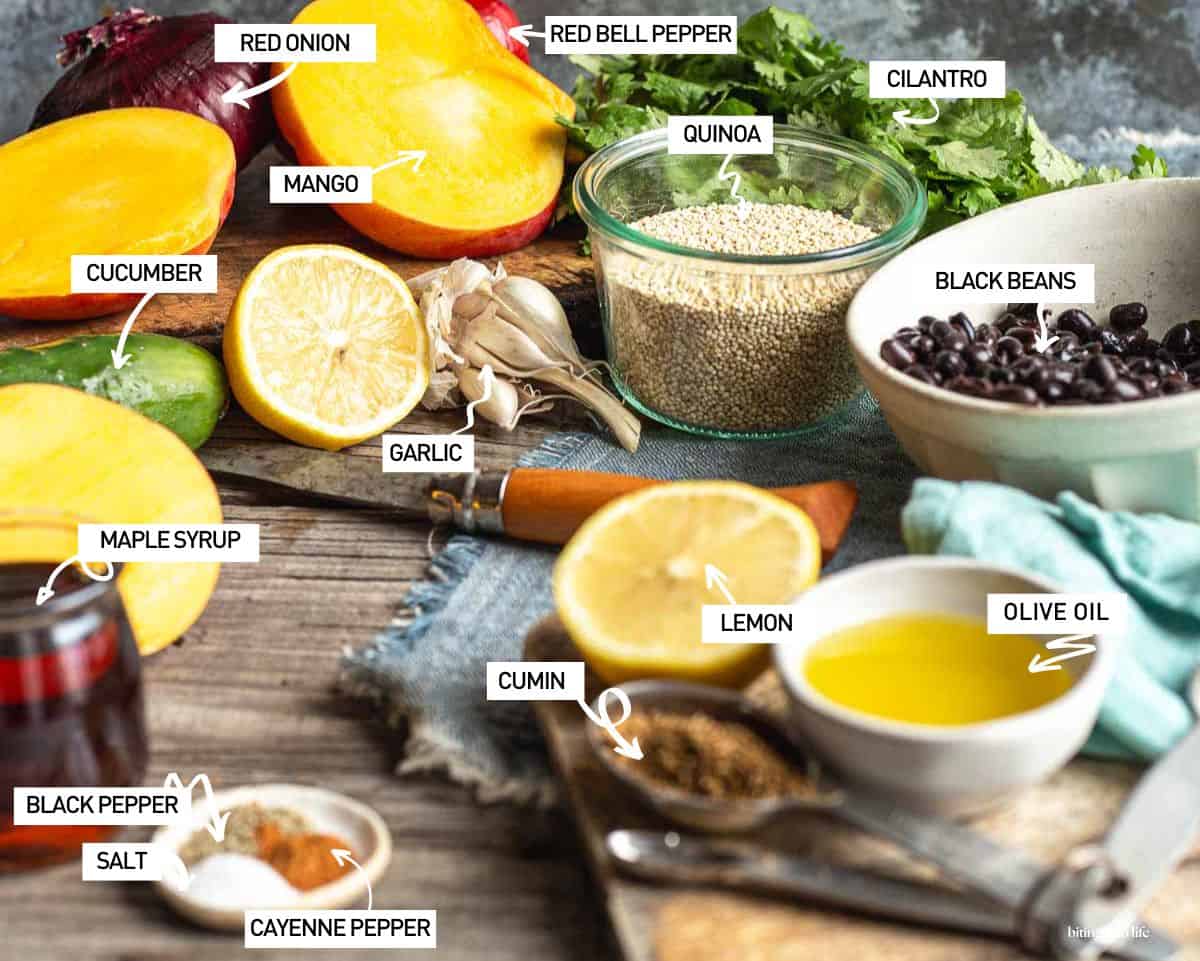
Notes
Some ingredients deserve special attention:
- Black beans. I opted for dry black beans. Canned beans work great for this recipe, but make sure they are thoroughly rinsed and drained before use.
- Mango. Choose a fresh, ripe mango for a natural sweetness that perfectly complements the rest of the salad.
- Cilantro. Take fresh cilantro for optimal flavor. If you're not a fan, you can replace it with fresh flat parsley.
Get Your Free Plant-Based Eating Toolkit and More
Subscribe to my newsletter and unlock my plant-based course, nutrition charts, recipe secrets, and exclusive updates to prepare wholesome, varied & balanced meals effortlessly. All you need is a good appetite. Subscribe!
How to Make this Quinoa and Mango Salad Step by Step
To start, I cook the quinoa as directed on the package, making sure to rinse it thoroughly in a fine sieve before cooking. While the quinoa cooks, I cut the mango, cucumber, red onion, red bell pepper and cilantro. Then I rinse the black beans and drain them well.
Once the quinoa is cooked and cooled, I mix it with the black beans, cut vegetables and cilantro ①②. I prepare the maple-lemon vinaigrette with olive oil, lemon juice, garlic, cumin, salt, and pepper ③. Finally, I pour it on the salad and mix well ④.
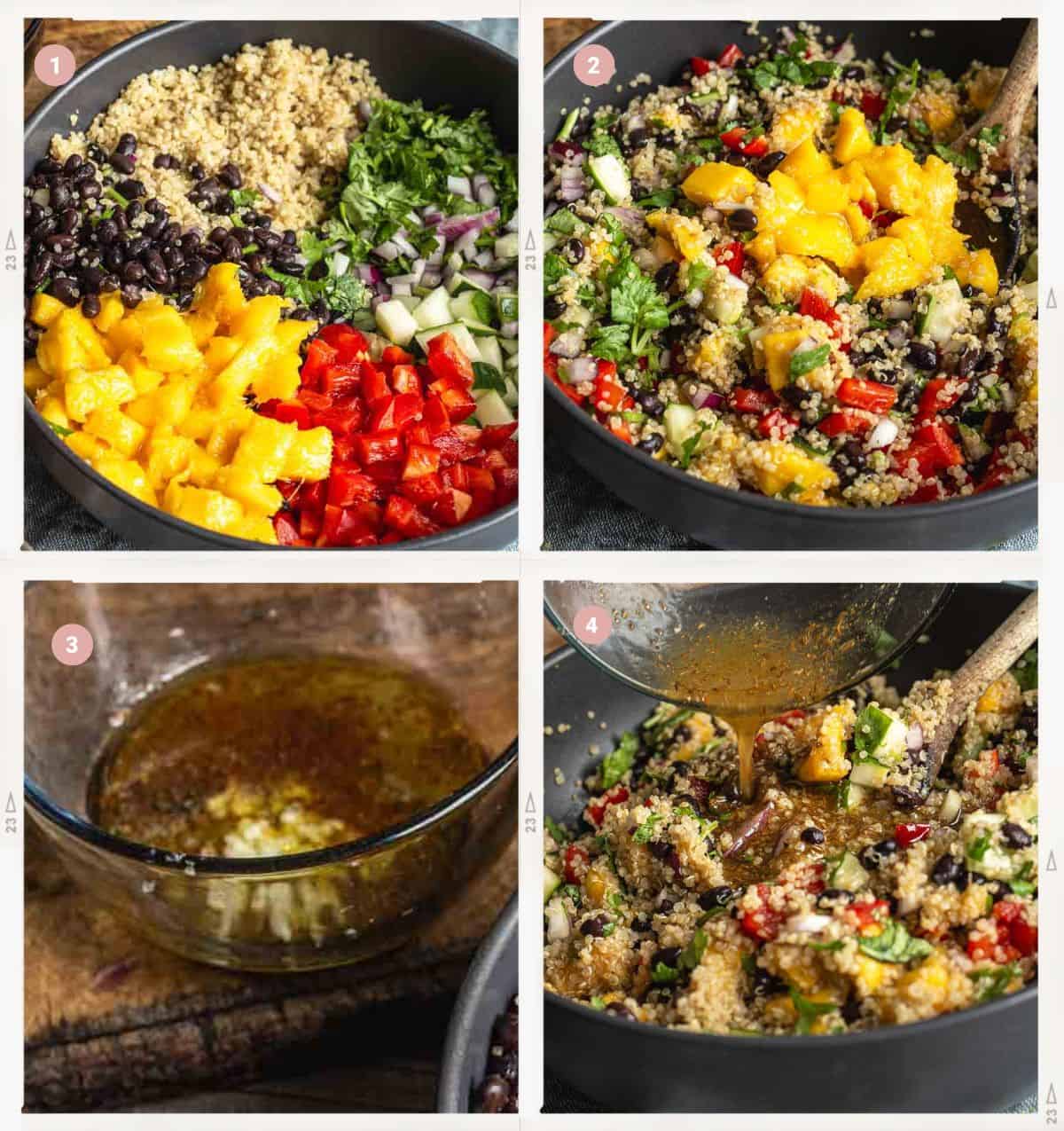
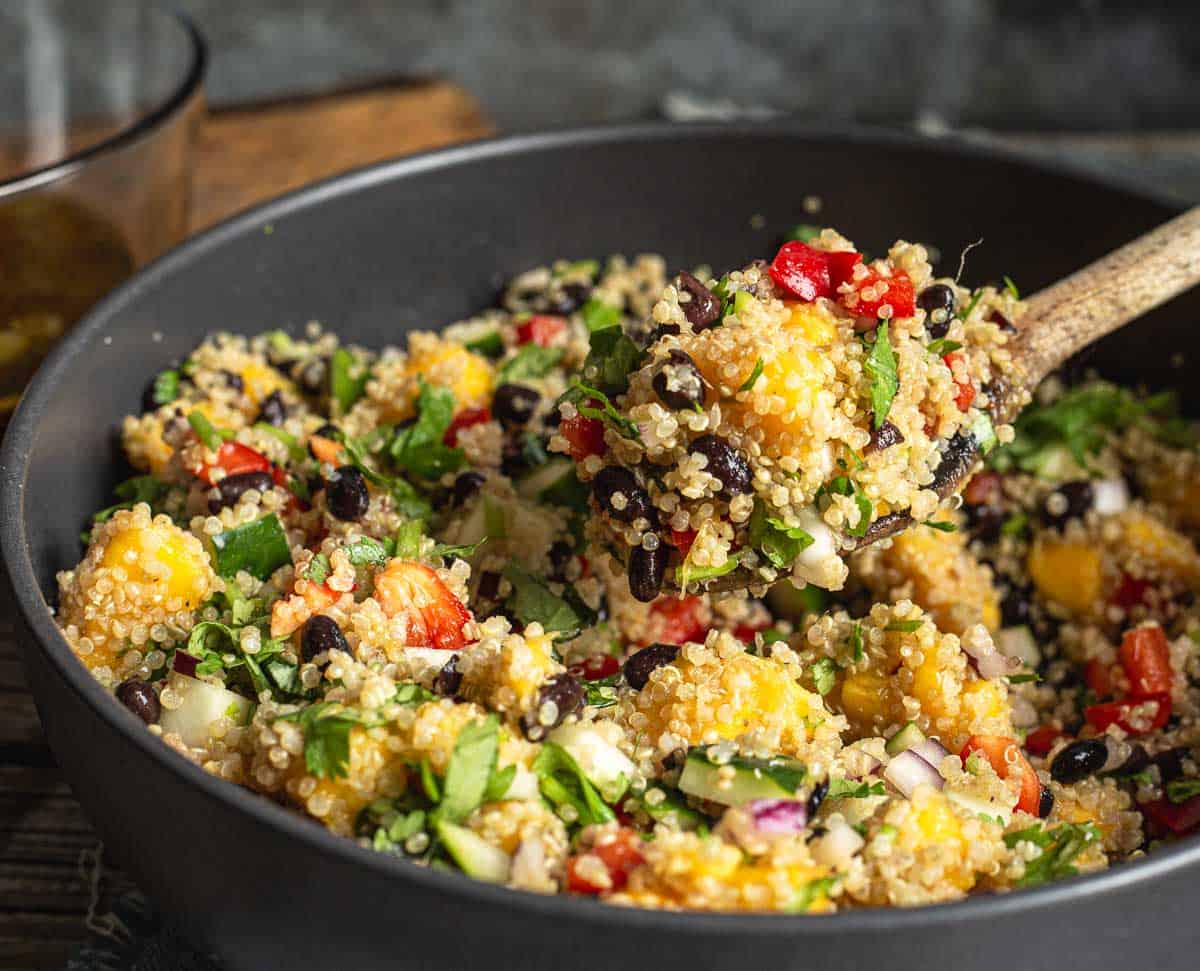
Essential equipment
To make this recipe, you will need:
- A sharp kitchen knife for cutting vegetables.
- A cutting board.
- A medium saucepan to cook the quinoa.
- A large bowl to mix all the ingredients.
- A colander to rinse black beans and quinoa.
- A wooden spoon to mix the ingredients well.
The Keys to Success: My Top Tips
Quinoa Clean to Drop the Mean. Be sure to rinse the quinoa thoroughly before cooking. This simple gesture helps get rid of its natural bitterness.
Mango Check for the Perfect Speck. Do not hesitate to taste the mango before adding it to the salad. It must be ripe to bring the sweetness necessary for the balance of flavors.
Stems in Hand, Make it Grand. When chopping the cilantro, include the stems. They are full of flavor and give a nice texture to the salad.
Beans and Drains, Skip the Pains. Use canned black beans to save time. But don't forget to rinse and drain them to remove excess salt and preservatives. For dry black beans, soak them 12 hours before and cook them until they're soft but not too mushy.
A Quick Taste, Perfects the Base. Taste the salad before serving and adjust the seasoning if necessary. A little more lime juice or a pinch of salt can make all the difference.
Simple Substitutions and Add-ins
If you can't find certain ingredients or just want to add a personal touch to the salad, here are some suggestions:
- Vary the fruit. Replace mango with pineapple or papaya.
- Switch red veggies. Put fresh tomatoes or cherry tomatoes instead of the red bell pepper.
- Interchange cereals. Quinoa can be substituted with couscous or brown rice.
- Adds a creamy touch. Incorporate a creamy avocado.
- Put some crunch in it. Add sunflower or pumpkin seeds.
- Bring up the heat. Add a sliced or finely diced jalapeño pepper.
- Substitute the beans. Opt for chickpeas instead of black beans.
The Special Diets Corner
If you have food intolerance, here are some ideas to make this dish...
- Low-FODMAP vegan. Make a simple quinoa salad and omit the red onion, mango and black beans.
Digestion problems?
If you suffer from digestive disorders, I recommend that you soak quinoa or dried beans in acidic water (with 1 to 2 tablespoons of vinegar or lemon) for 8 to 12 hours. This neutralizes problematic nutrients, or anti-nutrients. Then, rinse these ingredients well with fresh water.
Answers to Your Burning Questions (FAQ)
Absolutely! Quinoa is rich in protein and fiber, black beans are a great source of protein and fiber as well, and mango supplies a dose of vitamin C and antioxidants. This salad is a balanced meal.
Yes, you can. It's even better after a few hours in the fridge, allowing flavors to blend in.
You can use any type of quinoa: white, red or black. The choice depends on your personal preference. White quinoa has a lighter texture and a more subtle taste, while red and black quinoa has a crunchier texture and a slightly earthier taste.
Absolutely, this salad is very versatile. You can add other vegetables like tomatoes or avocados, herbs like parsley or mint, or even tofu grilled for an extra dose of protein.
Troubleshooting
Be sure to rinse your quinoa thoroughly before cooking. Quinoa has a natural layer of saponins that can make it a little bitter or sticky if not rinsed off thoroughly. Also, pay attention to your water and quinoa ratios. Generally, it's two parts water to one part quinoa.
Make sure the quinoa cooks thoroughly. If it stays hard after the suggested cooking time, you can add a little more water and extend the cooking time. Each brand of quinoa may have slightly different cooking times, so always check the cooking by tasting a grain.
Do not hesitate to adjust the dressing to your taste. Add a little more salt, pepper or lemon juice if necessary. You can also add more cilantro or other fresh herbs for freshness.
If this happens, let it ripen at room temperature for a few days. To speed up the ripening process, you can place the mango in a paper bag with an apple or banana.
If so, it's probably because it needs more dressing. Do not hesitate to add more and mix well so that all the ingredients are well coated.
How to Store It
This flavorful quinoa salad keeps well in the refrigerator in an airtight container for 3 to 5 days. It is best to keep the salad dressing separate until it's time to serve.
What to Serve this Dish with
Whether it you have a hot or cold quinoa salad, serve it as a main dish or a great side dish with:
- A wrap with grilled tofu
- Grilled vegetable skewers
- A freshly prepared vegetable soup
- Hummus and pita bread
- A vegan pizza.
More Light and High-Protein Recipes
Make this Black Bean Mango Salad Now
These days when everything goes by at a crazy speed, we all know. The feeling of having to sacrifice either health or speed? With this quinoa, mango and black bean salad, no need to choose. Simple, delicious and nourishing, it adapts to your frantic pace.
Prepare it in advance for meals on the go, serve it as a side dish or savor it alone for a light, filling break.
You'll fall in love with its fresh vegetables, vibrant colors, and fresh flavor.
Bring this summer quinoa salad for a potluck, your next barbecue or whatever. It's there for you.
So, ready to emancipate yourself from guilt and discover plant-based food? I know you can do it. Together, let's make your kitchen a place of magic.
Let's go!
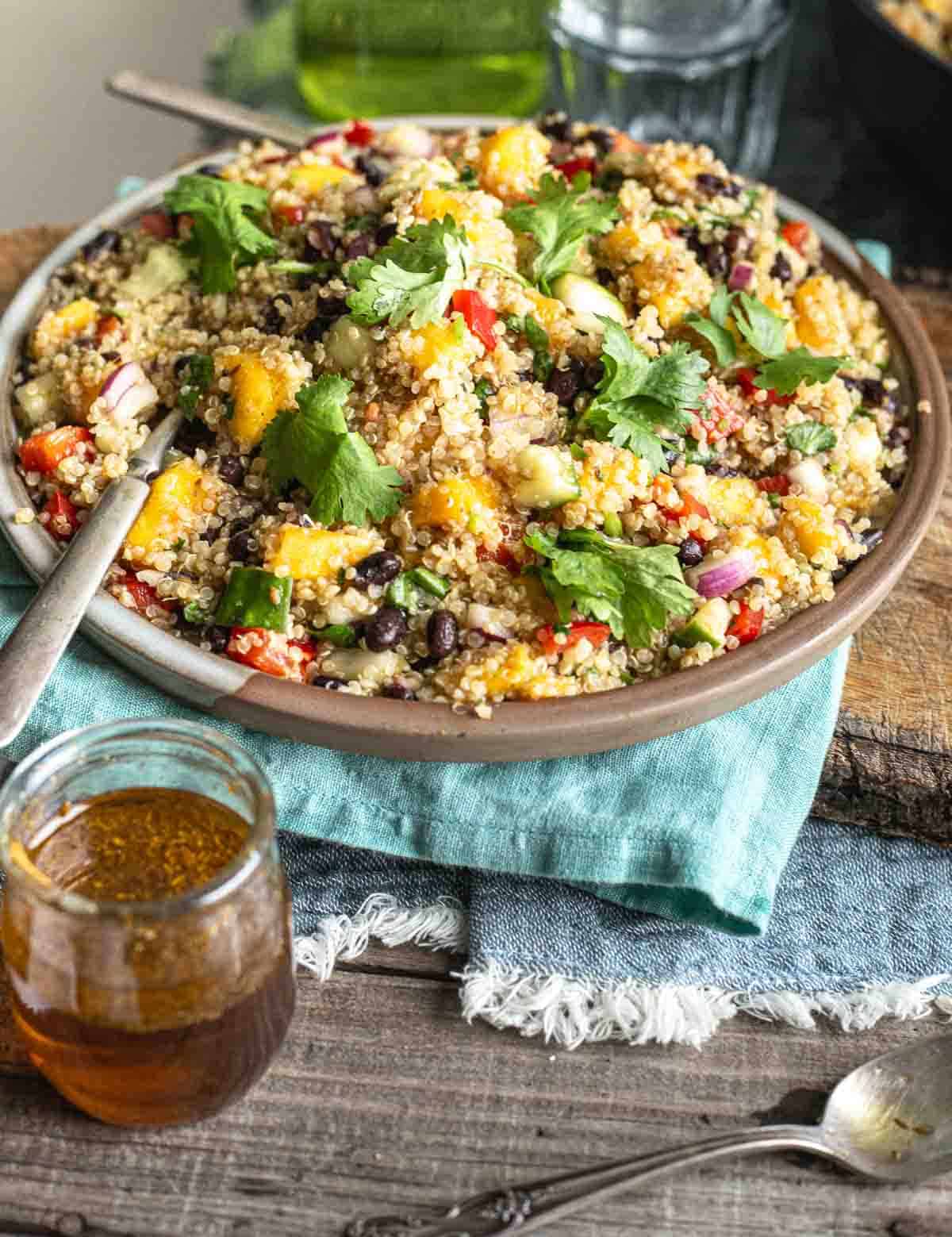
If you try this recipe, I want to know about it! I always appreciate your feedback. Leave a star rating in the recipe card right below and/or a review in the comment section further down the page. You can also follow me on Pinterest, Facebook, or Instagram. Sign up for my email list, too!
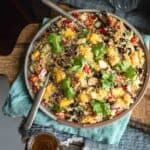
Mango Quinoa Salad Recipe
Ingredients
Quinoa salad
- 1 ½ cup quinoa cooked from 1 cup uncooked
- 1 ½ black beans cooked from 1 cup uncooked
- 1 cup diced mango
- 1 cup diced red bell pepper
- ½ cup diced cucumber
- ¼ cup diced red onions or green onions
- ½ cup minced cilantro
- Salt to taste
Dressing
- 3 tablespoons olive oil
- 3 tablespoons lemon juice or red wine vinegar
- 1 tablespoon maple syrup
- 2 teaspoons ground cumin
- ½ teaspoon garlic crushed
- 1 pinch cayenne pepper
- Pinch salt
Instructions
- In a large salad bowl, combine all the ingredients of the quinoa salad, except the cilantro, and toss well. Set aside.
- Make the salad dressing: in a small bowl, put all the ingredients and mix well. Pour over the quinoa salad and mix well. Add the cilantro and mix well.
- Serve immediately.
- Placed in an airtight container, this mango quinoa salad will keep for up to 3 to 5 days.
Notes
- Rinse the uncooked quinoa well into cold water before cooking to remove saponins. This simple gesture helps get rid of its natural bitterness.
- Cooking quinoa: for a perfect quinoa, put 1 cup quinoa into 2 cups water or salted water, and bring to a boil on high heat. As soon as the water reaches the surface of the quinoa, lower the intensity from low to medium heat, cover, and cook for about 15 minutes.
- Do not hesitate to taste the mango before adding it to the salad. It must be ripe to bring the sweetness necessary for the balance of flavors.
- When chopping the cilantro, include the stems. They are full of flavor and give a nice texture to the salad.
- Use canned black beans to save time. But don't forget to rinse and drain them to remove excess salt and preservatives. For dry black beans, soak them 12 hours before and cook them until they're soft but not too mushy.
- Taste the salad before serving and adjust the seasoning if necessary. A little more lime juice or a pinch of salt can make all the difference.
Variations
Feel free to add other veggies and nuts and seeds. Other variations may be:- Pineapple or Papaya Quinoa salad. Use pineapple or papaya instead.
- Mango Avocado Quinoa Salad. Add 1 avocado.
- Mango Quinoa Salad with tofu or tempeh. Add tofu or tempeh for an extra dose of protein
- Mango Chickpea Quinoa Salad. Opt for chickpeas instead of black beans.
- Low-FODMAP Mango Quinoa Salad. Make a simple quinoa salad by omitting the red onion, mango and black beans and use garlic-infused olive oil for flavor.
Nutrition
Get Your Free Plant-Based Eating Toolkit and More
Subscribe to my newsletter and unlock my plant-based course, nutrition charts, recipe secrets, and exclusive updates to prepare wholesome, varied & balanced meals effortlessly. All you need is a good appetite. Subscribe!


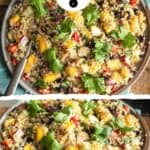
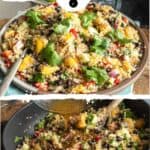
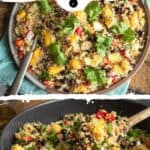
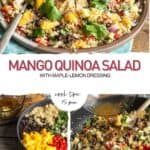
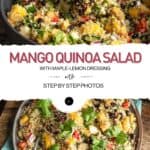
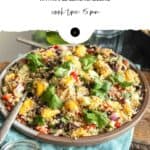
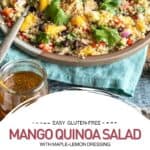
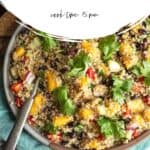
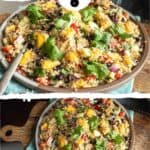
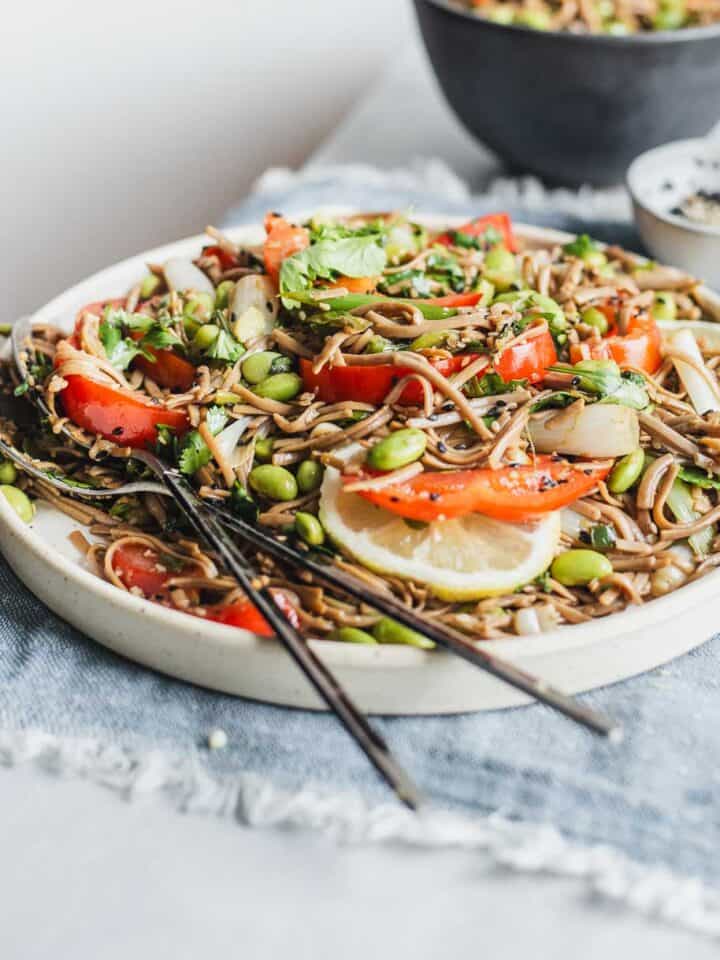
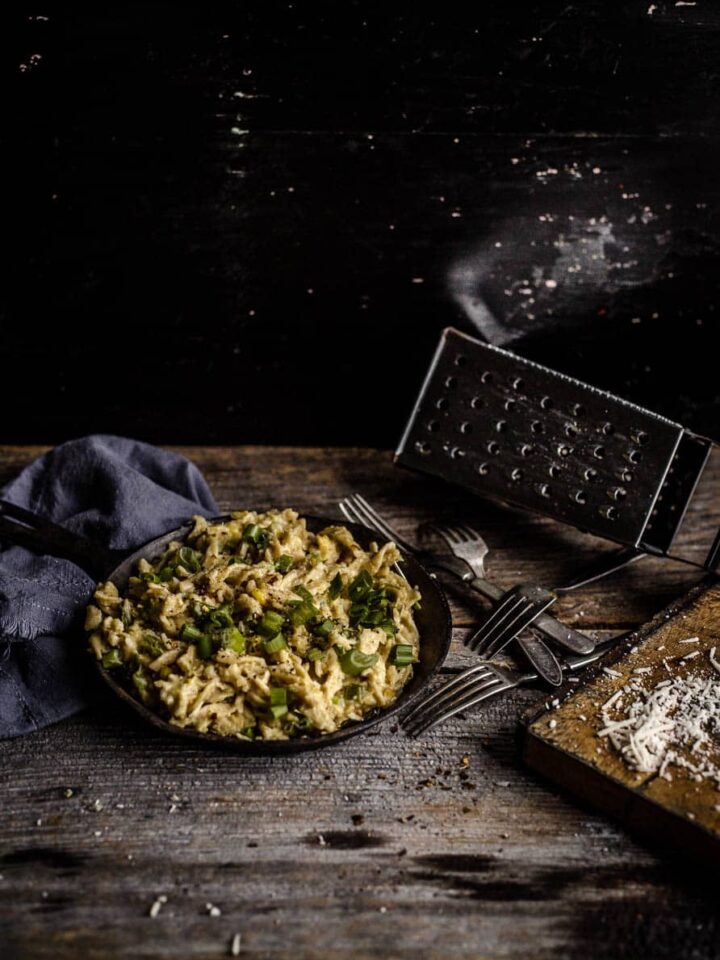
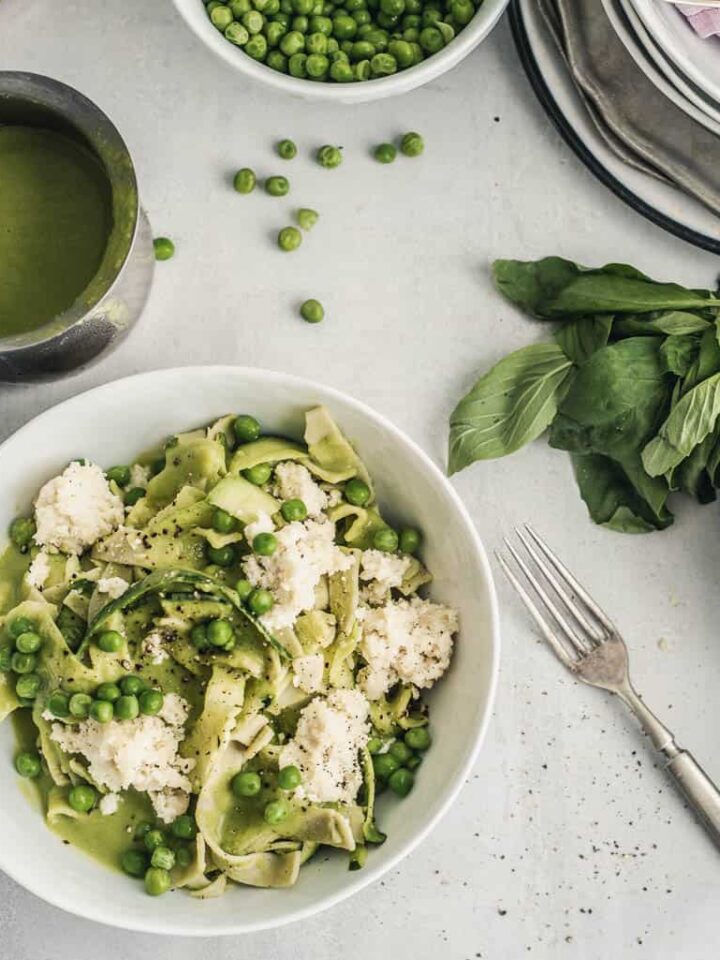

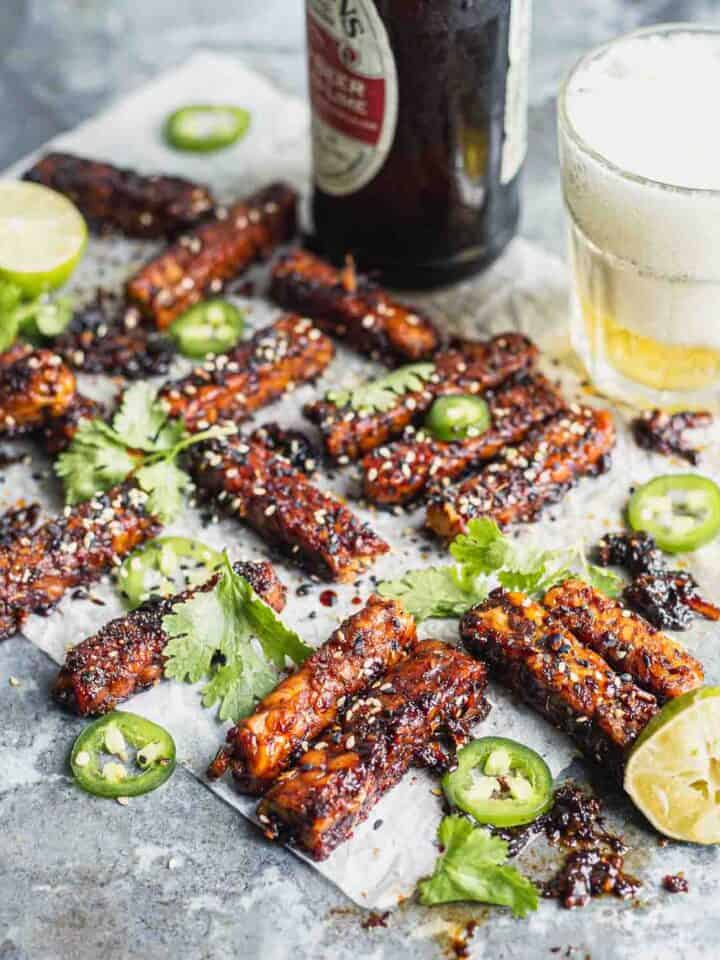
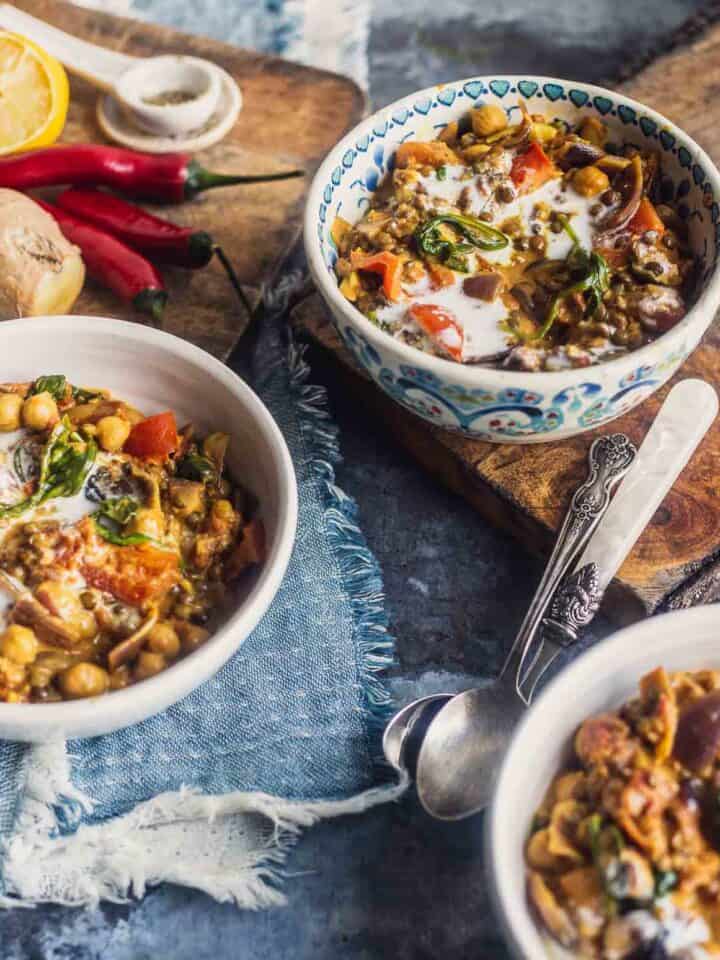

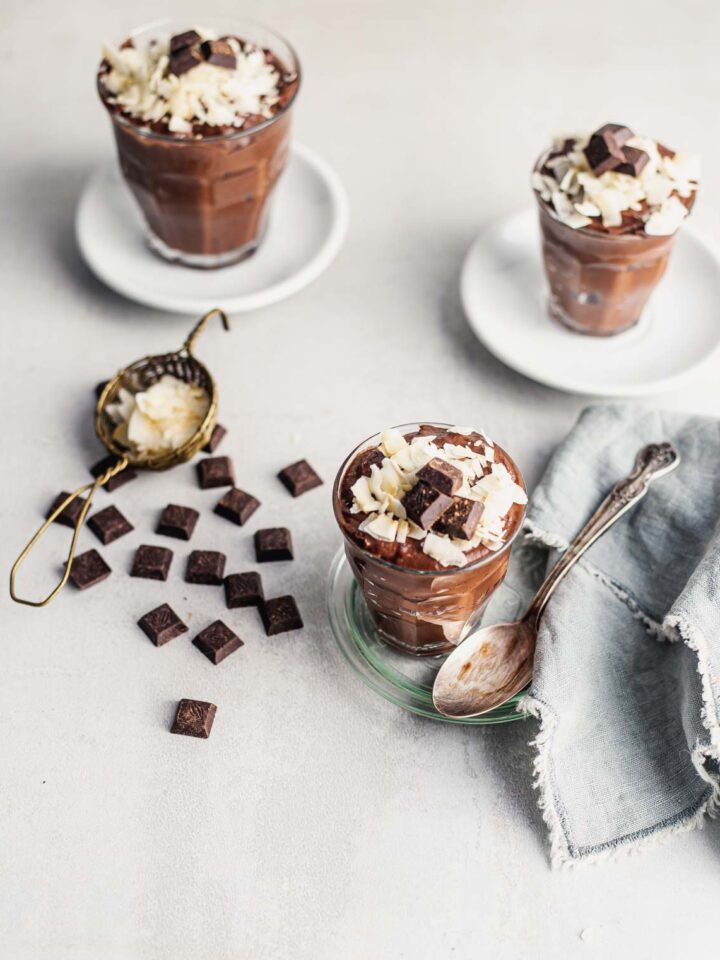
Leave a Reply